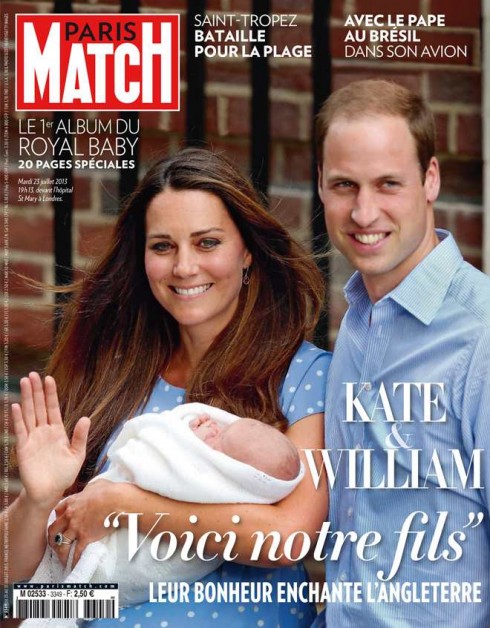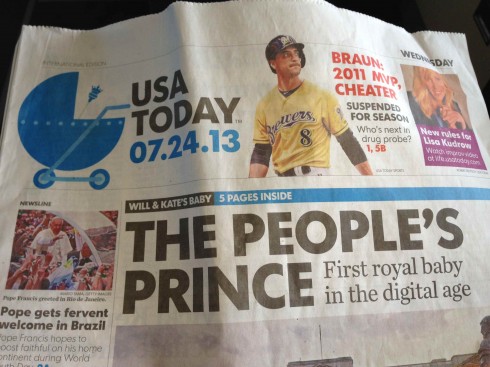TAKEAWAY: Publishers and editors are becoming more aware of the importance of frequency for their products. In a digital world, some of the traditional patterns for publication frequency are thrown off balance by the users’ appetite for consumption of information. ALSO: How Paris Match got the Royal Baby and his parents on this week’s cover

Daily. Weekly. Monthly.
That’s not just how most calendars organize the events around us. It is also the most traditional way for publishers to create time compartments for the information they process and pass on to their audiences.
It is also, in my view, how people inside a newsroom begin to think. I have spent enough time inside daily newspaper newsrooms to know that editors clock in and out of 24-hour cycles. They come to produce tomorrow’s newspaper today. That’s how their world operates.
For those who produce weeklies, it is a 7-day cycle of activity, with the early start of the week slow and relaxing, climaxing into a flurry of activity just before that cover story for the week is selected and executed.
For the monthlies, tons of leisure—-the envy of those editors who have to produce the goods with greater frequency.
All of that is now in a state of happy flux.
Few newspaper editors who are successful today live in the 24-hour time warp.
And editors of weeklies, such as our friends at Paris Match, the iconic French magazine, are experimenting with smartphone editions that may bring some of the magazine’s content to new audiences right on the phone as many as three times a day.
So, I am not surprised to read this Poynter piece about such well known monthlies as Esquire and The Atlantic have now created Esquire Weekly for iPad and The Atlantic Weekly for iPad and iPhone, launched in May and June, respectively.
Here is a highlight of that piece:
With Esquire Weekly and The Atlantic Weekly, two monthly legacy print publications are trying different formulas for getting compact editions in front of readers with a frequency they can’t achieve in print and a level of curation they can’t achieve online. The two take different approaches to content selection, target audience and distribution, but what’s most important about these new initiatives is what they have in common: ease and frequency of delivery, tender editorial care, digestible length and, surely, low cost of production.They’re also, crucially, products that could only work on the tablet
I see this as a great move. A month is a long time to wait from one issue to the next in the tablet, that one platform that we turn to several times a day.
This also means more curation of the material. It is not simply a 100% transfer of what the monthly publication includes. It can’t be. It also accentuates our belief that successful tablet journalism is a mixture of lean forward and lean back experiences. A weekly version of a publication will tend to be a little newsier, as not only is the frequency increased, but also the chronological proximity to events that affect the reader.
Speaking of Paris Match—and frequency of publication

Cover of this week’s Paris Match
It was not just the world that was waiting for the Royal Baby to arrive this week. For Olivier Royant, the editor of Paris Match, and his team, it was important to get that news and photo on the cover of this week’s magazine.
And they did.
The Royal Baby (now we know he is named George) was born at 16:20 London time Monday, July 22, and the photo of the proud new parents showing the heir to the throne was printed Wednesday, on time to be the first French magazine to carry the story on its cover.
But it was not easy to get to that point. In the words of Olivier:
While Prince Williams and Kate described their experience of becoming parents as « very emotional », Tuesday evening at Paris Match’s newsroom the feeling was rather tense and anxious. We were already 5 hours behind our deadline with a clear threat of not being able to reach the newsstands by Thursday. Still the doors of St Mary’s Hospital in London were remaining desperately closed. We decided to wait one more hour. Our readers expect an absolute « news reactivity » from their magazine and would not forgive us for missing such an event. So when the Duke and Duchess of Cambridge finally emerged from the maternity Tuesday evening to show the world their Royal Baby….we really loved that baby !
Pages we like

Just when we were beginning to get a little tired of that big circle that is part of the new (not so new anymore!) logo for USA Today, here is one day when the conversion of the circle to accommodate the news of the day worked well, in a fun way.
Of special interest
Royal baby: news of birth gives boost to newspaper websites
http://www.guardian.co.uk/media/2013/jul/23/royal-baby-news-boost-websites
Native advertising isn’t what you think it is
http://blog.wan-ifra.org/2013/07/22/native-advertising-isn-t-what-you-think-it-is
Ads Above the Fold Are Not More Viewable – So why are they priced at a premium?